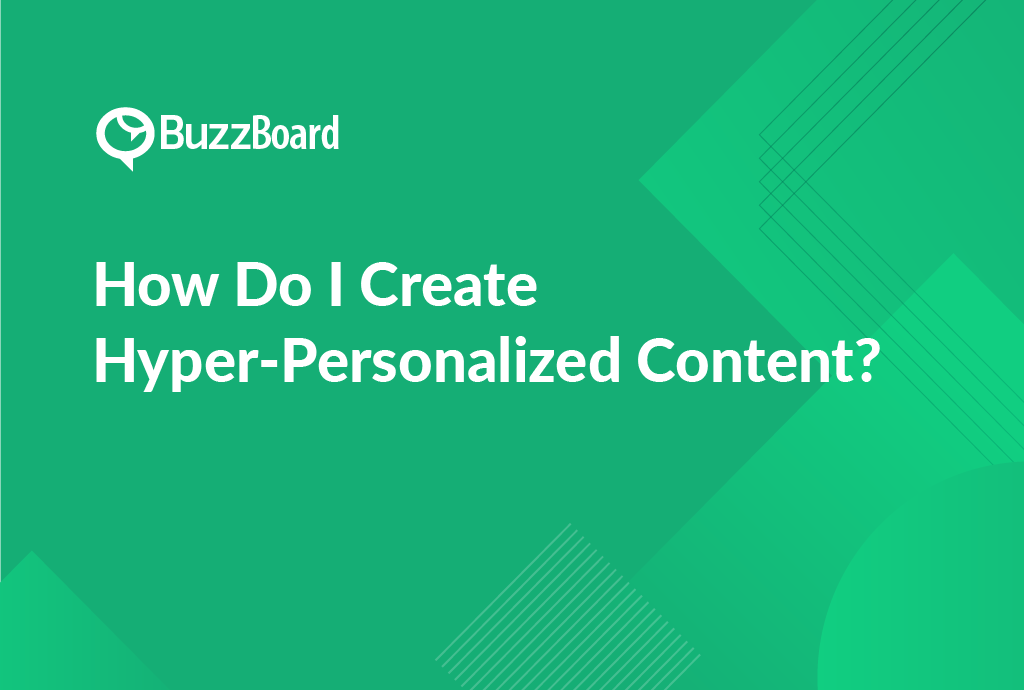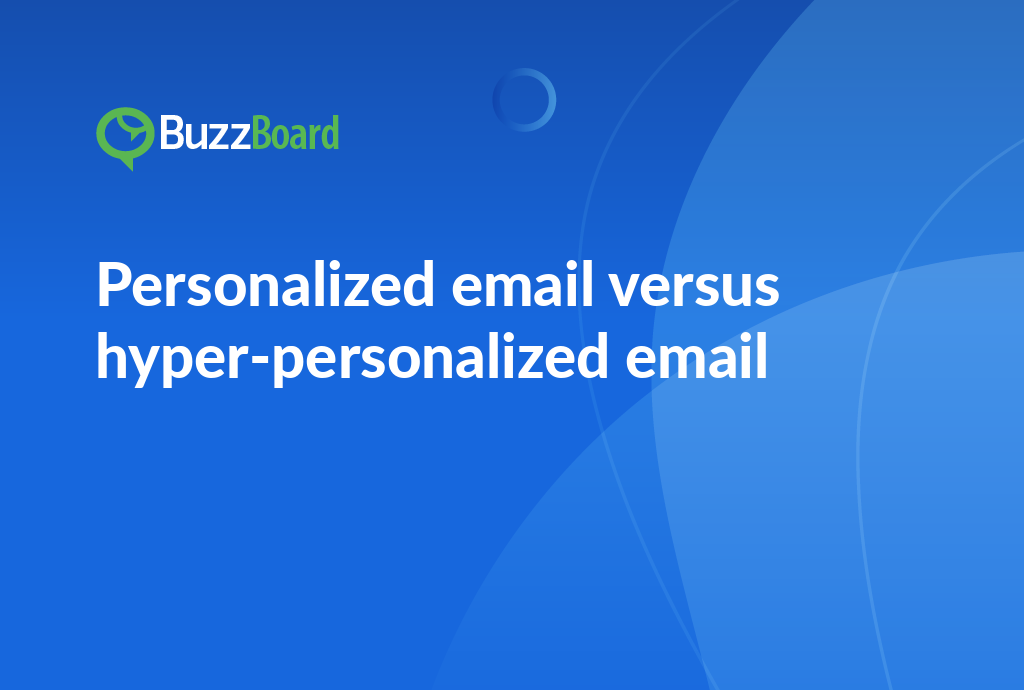To create hyper-personalized content, start by identifying your target audience and gathering data on their preferences, behaviors, and interests. Use this data to create buyer personas and tailor your content to their specific needs and pain points. Next, leverage technology such as AI-powered content optimization tools and customer relationship management (CRM) software to analyze user interactions and adjust your content in real-time. Finally, use this data to create dynamic content that is tailored to each individual user, increasing engagement and conversion rates.
Hyper-Personalized Content in Today’s Digital Marketing World
In today’s digital marketing environment, hyper-personalized content is a critical tool, not just a buzzword. It’s a game-changer that is transforming the face of content marketing through a nuanced content creation approach.
Hyper-personalized content elevates customer experience by focusing on individuals instead of broad segments. It uses real-time data to produce highly relevant messages designed specifically for each recipient, enhancing engagement and facilitating robust customer-brand relationships.
For small and local businesses, hyper-personalized content has a massive impact. It enables a direct conversation with customers, addressing their unique needs while differentiating your brand from competitors. This type of personalization boosts customer loyalty and yields higher returns on investment.
Creating compelling content is no longer enough to stand out from the competition. Hyper-personalization, which involves not only crafting tailored content but also strategically distributing it to the right audience at the right time, has become a crucial aspect of digital marketing. A well-thought-out digital marketing strategy is essential to ensure that your personalized content reaches your target audience when they are most receptive to it.
For sales representatives at digital marketing agencies, understanding and leveraging hyper-personalization is vital to providing exceptional services to their clients. By offering this service, agencies can differentiate themselves from competitors and establish themselves as thought leaders in the industry. This, in turn, can lead to increased client satisfaction, loyalty, and ultimately, revenue growth.
To truly appreciate the value of hyper-personalization, it’s essential to stay up-to-date with the latest industry trends and insights. The digital marketing landscape is constantly evolving, with new technologies, platforms, and tools emerging regularly. To remain relevant, it’s crucial to continuously educate yourself on the latest developments and best practices in hyper-personalization.
One of the key benefits of hyper-personalization is its ability to amplify a brand’s message and increase its impact. By tailoring content to specific audience segments, businesses can create a more meaningful connection with their target audience, leading to increased engagement, conversions, and ultimately, revenue growth. Moreover, hyper-personalization allows businesses to optimize their marketing efforts, reducing waste and improving ROI.
To maximize the potential of hyper-personalization, it’s essential to have a deep understanding of your target audience. This includes knowing their preferences, behaviors, and pain points, as well as their buying habits and decision-making processes. By leveraging this information, businesses can create content that resonates with their audience, increasing the likelihood of conversion.
Another critical aspect of hyper-personalization is the use of data and analytics. By leveraging data and analytics, businesses can gain insights into their audience’s behavior and preferences, allowing them to refine their marketing efforts and optimize their content for maximum impact.
Hyper-personalization is a powerful tool that can help businesses stand out in a crowded digital landscape. By creating tailored content and strategically distributing it to the right audience at the right time, businesses can increase engagement, conversions, and revenue growth. To truly appreciate the value of hyper-personalization, it’s essential to stay updated with industry trends and insights, and to continuously educate yourself on the latest developments and best practices in this field. By doing so, businesses can establish themselves as leaders in their industry and reap the rewards of hyper-personalization.
Explore the Various Strategies and Technological Tools Used in Creating Hyper-Personalized Content
Hyper-personalized content has emerged as a vital component for effectively targeting small and local businesses. This process involves the meticulous customization of content to cater to the unique needs of each customer, leveraging their behavioral data, prior interactions, or demographic information to create a tailored experience.
To achieve this level of personalization, a multitude of strategies and technological tools can be employed. Content creation platforms, for instance, offer advanced tools for developing bespoke content that resonates with specific audiences. These platforms are instrumental in streamlining the hyper-personalization process, whether it’s through personalized emails, web content, or social media posts. By leveraging these platforms, marketers can create content that is not only tailored to individual customers but also optimized for specific channels and devices.
Content marketing automation tools also play a crucial role in the hyper-personalization process. These tools can autonomously collect and analyze user data, allowing for more accurate personalization and enabling marketers to create content that is relevant to each customer’s unique preferences and behaviors. Marketing automation software, such as HubSpot or MailChimp, boasts a range of features that work in synergy to hyper-personalize content marketing strategies, including email marketing, social media scheduling, CRM, and more.
To further enhance the potency of hyper-personalization, incorporating AI-powered analytics into your digital marketing toolbox can provide a significant advantage. These advanced systems can handle large data sets, yielding predictive insights and a profound understanding of customer preferences in unprecedented depth. This leads to a more nuanced comprehension of your audience, resulting in increasingly personalized content that resonates with customers on a deeper level.
However, mastering the implementation of hyper-personalized content into your digital marketing strategy requires a thorough understanding of customer data, meticulous planning, and proficient execution. Marketers must be able to collect, analyze, and interpret vast amounts of data to create a comprehensive customer profile. This involves identifying key demographics, behaviors, and preferences, as well as understanding how these factors intersect and influence customer decision-making.
To achieve this level of sophistication, marketers must be willing to invest time and resources in developing a robust data management strategy. This includes implementing data collection and analysis tools, as well as establishing clear data governance policies to ensure the accuracy and integrity of customer data.
In addition to data management, marketers must also develop a clear content strategy that is aligned with their business goals and target audience. This involves creating a content calendar that outlines the types of content to be created, the channels through which it will be distributed, and the metrics by which its success will be measured.
Finally, marketers must be able to execute their hyper-personalization strategy with precision and finesse. This involves leveraging the right tools and technologies to create and distribute personalized content, as well as continuously monitoring and optimizing the performance of that content to ensure maximum ROI.
By following these best practices and leveraging the latest technologies and strategies, marketers can unlock the full potential of hyper-personalization and create a competitive advantage in the digital marketing landscape.
The Role of Customer Insights and Data Analytics in Hyper-Personalizing Content to Enhance User Engagement
It is crucial for sales representatives at digital marketing agencies to have a deep understanding of the pivotal role that customer insights and data analytics play in driving successful content marketing strategies. At the heart of this is the concept of hyper-personalization, which involves tailoring content to align with an individual customer’s unique needs, preferences, and behaviors.
Hyper-personalized content is a game-changer in the world of content marketing, as it moves beyond simply addressing customers by their names or sending generic birthday wishes. Instead, it involves delving into a customer’s digital footprint, examining their past interactions, and using these insights to craft content that not only captures their attention but also maintains their engagement. This level of personalization requires a deep understanding of customer behavior, including their browsing habits, purchase patterns, and social media interactions.
Data analytics plays a significant role in content creation, particularly for small and local businesses catering to a niche audience. By analyzing vast amounts of customer data, including demographics, behavioral data, purchase patterns, and social media interactions, businesses can uncover valuable insights that inform their content strategy. These insights can be used to create hyper-personalized content that resonates with customers, resulting in increased user engagement and a superior return on investment.
In today’s digital marketing landscape, relevance is the key to success. Failing to incorporate customer insights and data analytics into a content strategy can lead to a disconnect with the target audience, resulting in missed opportunities and a lack of engagement. On the other hand, adopting these tools and techniques can be the difference between businesses that merely endure and those that thrive.
To achieve hyper-personalization, businesses must be willing to invest time and resources into understanding their customers. This involves collecting and analyzing data from various sources, including social media, email marketing campaigns, and customer feedback. By leveraging this data, businesses can create content that is tailored to individual customers’ needs, preferences, and behaviors.
Moreover, data analytics can help businesses identify patterns and trends in customer behavior, allowing them to refine their content strategy and optimize their marketing efforts. For example, by analyzing customer purchase patterns, businesses can identify which products or services are most popular and create targeted content that resonates with customers.
In addition, data analytics can help businesses measure the effectiveness of their content strategy, allowing them to track key performance indicators such as engagement rates, conversion rates, and return on investment. By analyzing these metrics, businesses can refine their content strategy and make data-driven decisions that drive results.
Customer insights and data analytics are essential tools for sales representatives at digital marketing agencies. By leveraging these tools, businesses can create hyper-personalized content that resonates with customers, drives engagement, and generates a superior return on investment. In today’s digital landscape, relevance is key, and adopting customer insights and data analytics can be the difference between businesses that merely endure and those that flourish.
Providing a Step-by-Step Guide on How to Create Hyper-Personalized Content Including the Different Phases of Content Creation
As a sales representative at a digital marketing agency, your role necessitates creating striking, impactful content that can bolster profit and propel business growth. Hyper-personalized content is a significant success driver in content marketing, especially for small and local businesses.
Here is a step-by-step guide on curating such content:
The most critical part of content creation involves gathering data about the audience. This phase equips you with invaluable knowledge about the target audience’s traits, including their preferences, needs, and behaviors.
With a clear projection of the audience’s persona, you can define the tone and voice of the content. Does your audience lean more towards professional, authoritative content, or an informal, conversational style?
Create your content based on identified preferences. Don’t forget to weave in the Latent Semantic Indexing (LSI) keywords: content creation, digital marketing, and hyper-personalizing content. These will enhance Search Engine Optimization (SEO) and heighten search engine visibility.
In this phase, individualize the message in your content, proffering a distinctive and personalized experience to each audience member.
Lastly, gauge the content’s performance using tools such as Google Analytics. This analysis will help determine if your hyper-personalized content drives the desired engagement and conversions.
Remember, hyper-personalization doesn’t equate to intrusiveness. Always respect your audience’s privacy while providing them with better, more targeted experiences.
Discussing the Benefits and End Goals of Hyper-Personalized Content in Reaching and Converting Target Customers
Content marketing has emerged as a powerful tool for small and local businesses to reach and convert their target customers. However, to truly resonate with audiences and stand out from the competition, the deployment of hyper-personalized content is essential. Hyper-personalization involves tailoring content to align with the unique needs, preferences, and behaviors of individual customers, fostering a deep and meaningful connection with them.
To achieve this level of personalization, businesses must first gather comprehensive customer insights through various data sources, including customer feedback, purchase history, browsing behavior, and social media interactions. This information enables businesses to create content that is tailored to each customer’s specific interests, needs, and pain points, rather than simply sending generic messages to a large audience.
The benefits of hyper-personalized content are numerous. For instance, it can significantly elevate customer engagement and brand loyalty, leading to improved conversion rates and sales growth. According to a study by OneSpot, a leading marketing research firm, personalized content can result in a 20% uptick in sales. Additionally, hyper-personalization can also enhance SEO by aligning content with the audience’s real-time demands, thereby optimizing a business’s search engine rankings.
However, creating hyper-personalized content requires a deep understanding of the audience, including their likes, dislikes, and digital behavior. This necessitates the use of innovative content creation techniques, such as AI-powered content generation, dynamic content optimization, and customer journey mapping. By employing these techniques, businesses can effectively customize their messaging, enhancing the customer experience and building trust with their audience.
Moreover, hyper-personalization can also help businesses to better understand their customers’ needs and preferences, enabling them to make data-driven decisions and optimize their marketing strategies. By analyzing customer behavior and feedback, businesses can identify areas for improvement and adjust their content strategy accordingly.
In conclusion, while content is indeed king, hyper-personalized content is the gateway to the throne. By leveraging the power of hyper-personalization, businesses can create a loyal customer base, drive sales growth, and establish a strong online presence. To participate in this revolution and bolster their digital marketing strategy, businesses must be willing to invest in the tools and techniques necessary to create hyper-personalized content that resonates with their audience.
Some key takeaways for businesses looking to implement hyper-personalization include:
- Gathering comprehensive customer insights through various data sources
- Using innovative content creation techniques, such as AI-powered content generation and dynamic content optimization
- Creating content that is tailored to each customer’s specific interests, needs, and pain points
- Analyzing customer behavior and feedback to make data-driven decisions
- Continuously optimizing and refining the content strategy based on customer feedback and behavior
By following these best practices and embracing the power of hyper-personalization, businesses can create a loyal customer base, drive sales growth, and establish a strong online presence in today’s competitive digital landscape.
Conclusion
Creating hyper-personalized content requires a deep understanding of your audience and the ability to tailor your content to their unique needs, preferences, and behaviors. By leveraging data and analytics, you can create content that is highly relevant and engaging to your target audience, increasing the likelihood of conversion and loyalty. The article highlights the importance of using customer data to inform content creation, as well as the use of AI and machine learning to automate the content personalization process.
To create hyper-personalized content, marketers must first identify their target audience and gather data on their interests, behaviors, and preferences. This data can be used to create buyer personas, which serve as a guide for content creation. Additionally, marketers can use AI-powered tools to analyze customer data and identify patterns and trends that can inform content creation.
The article also emphasizes the importance of using multiple channels to deliver hyper-personalized content, including email, social media, and content marketing. By using a combination of channels, marketers can reach their target audience where they are most active and engaged.
Finally, the article notes that hyper-personalization is not a one-time task, but rather an ongoing process that requires continuous monitoring and optimization. Marketers must regularly review and refine their content to ensure it remains relevant and effective in reaching their target audience.
By following these steps and staying up-to-date with the latest trends and technologies in content personalization, marketers can create hyper-personalized content that drives real results and sets their brand apart from the competition.









